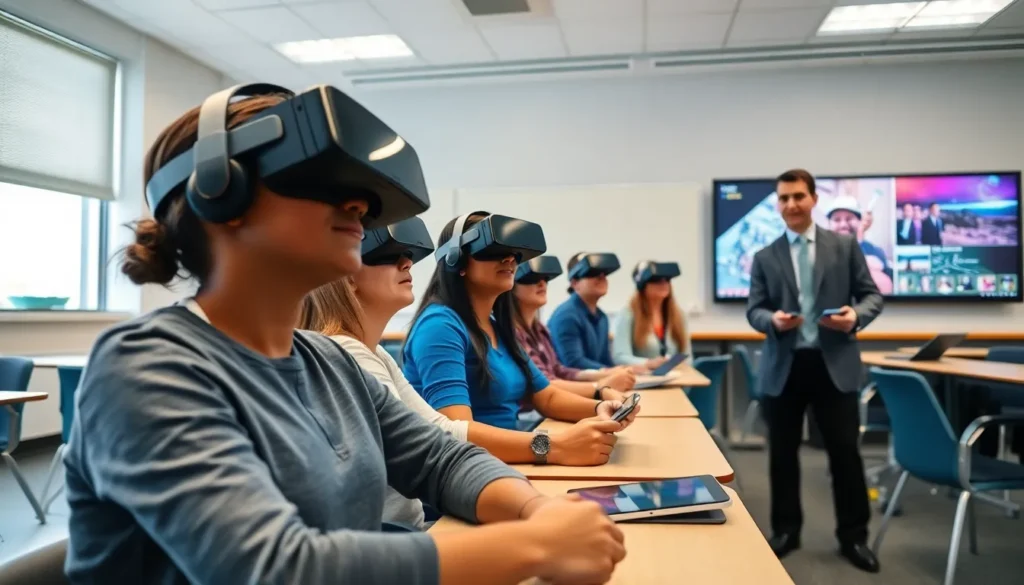Table of Contents
ToggleIn today’s digital age, screens are practically glued to our faces. Whether it’s scrolling through social media or binge-watching the latest series, blue light is lurking everywhere, ready to wreak havoc on sleep and eye health. It’s like that uninvited guest who overstays their welcome at a party—annoying and just a bit too bright!
But fear not! Reducing blue light doesn’t require a magic wand or a secret potion. With a few simple tweaks, anyone can create a more comfortable viewing experience. Imagine a world where your eyes aren’t screaming for mercy after hours of screen time. Sounds dreamy, right? Let’s dive into some effective strategies to keep those pesky blue rays at bay and reclaim your nighttime peace.
Understanding Blue Light
Blue light originates from various sources, including digital screens, LED lights, and sunlight. It plays a significant role in regulating circadian rhythms, influencing sleep patterns, and impacting overall health. Exposure to blue light, especially during evening hours, can disrupt melatonin production. This disruption can lead to difficulties falling asleep and maintaining restful sleep.
Studies indicate that excessive blue light exposure contributes to eye strain, known as digital eye strain or computer vision syndrome. Symptoms include discomfort, headaches, and blurred vision. Increased screen time amplifies these effects, highlighting the need for proactive measures.
The impact of blue light extends beyond immediate discomfort. Long-term exposure may lead to more serious vision issues, including potential damage to retinal cells. Research suggests that blue light can increase the risk of developing age-related macular degeneration, a significant concern for many.
Understanding the sources and effects of blue light emphasizes the importance of managing exposure. Simple strategies can reduce blue light impact effectively. Utilizing features on devices, like night mode or blue light filters, promotes healthier screen time. Additionally, wearing blue light blocking glasses can further decrease exposure.
Prioritizing actions to minimize blue light can enhance overall well-being. Consider adjusting screen brightness, taking regular breaks from devices, and limiting screen time in the evening. Implementing these measures fosters better sleep and eye health. Over time, these adjustments create a more comfortable environment for both work and leisure activities.
Importance of Reducing Blue Light
Reducing blue light exposure plays a crucial role in maintaining overall health and well-being. Understanding its impacts can guide effective strategies for minimizing exposure.
Health Impacts
Digital eye strain often occurs due to prolonged blue light exposure from screens. Symptoms include discomfort, dry eyes, headaches, and blurred vision. Studies indicate that regular exposure can heighten the risk of developing serious eye conditions. Age-related macular degeneration represents one such condition, and its prevalence increases with blue light exposure. Protecting eye health becomes essential in today’s screen-centric environment.
Effects on Sleep
Increased blue light exposure in the evening interferes with melatonin production. Despite its importance in regulating sleep cycles, melatonin levels drop when exposed to blue light at night. Many individuals experience trouble falling asleep or waking frequently during the night. Research demonstrates that limiting screen time before bedtime promotes more restful sleep and improves overall sleep quality. Prioritizing blue light reduction enhances nighttime routines and fosters better rest.
Methods to Reduce Blue Light on Screen
Reducing blue light exposure is essential for improving sleep quality and eye comfort. Different strategies exist to help manage this issue effectively.
Software Solutions
Utilizing software adjustments can substantially limit blue light exposure. Most devices have built-in night mode settings that filter out blue light during evening hours. Apps such as f.lux or Night Shift automatically adjust screen hues based on the time of day, providing a warmer light. Users can also manually tweak brightness and contrast levels to create a more comfortable viewing experience. Regularly updating software ensures access to the latest features and optimizations for blue light reduction.
Hardware Solutions
Investing in hardware solutions effectively minimizes blue light exposure. Blue light filtering screen protectors are available for various devices, blocking harmful rays from entering the eyes. Many monitors and laptops come equipped with eye care technologies designed to reduce blue light emissions directly from screens. Additionally, wearing blue light blocking glasses offers protection without the need for screen modifications. Choosing energy-efficient LED bulbs also contributes to reduced blue light in the surrounding environment. Prioritizing these hardware solutions supports long-term eye health.
Lifestyle Changes to Mitigate Blue Light Exposure
Adjusting screen settings is crucial in reducing blue light exposure. Many devices now feature built-in night modes, which shift the screen colors to warmer tones during evening hours. Users can also lower brightness levels for comfort while decreasing glare and strain. Experimenting with contrast settings helps enhance readability without overexposing the eyes to harsh light. Regularly updating software ensures optimal performance of these features, further minimizing blue light impact.
Using screen filters serves as an additional strategy to reduce blue light exposure. Filtering solutions are available as both software applications and physical attachments. Software options, like f.lux or Night Shift, change screen coloration for optimal comfort during nighttime use. On the other hand, physical filters can be applied directly to screens, blocking a significant portion of blue light. Choosing filters that suit individual needs promotes a more comfortable environment, especially when spending extended periods in front of digital displays.
Conclusion
Reducing blue light exposure is essential for maintaining eye health and improving sleep quality. By implementing simple strategies like using night mode settings and investing in blue light blocking glasses, individuals can create a more comfortable digital environment. Regular breaks from screens and adjusting brightness levels further enhance this experience.
These adjustments not only alleviate discomfort from digital eye strain but also support better melatonin production for restful sleep. By prioritizing these techniques, anyone can enjoy a healthier relationship with their devices while safeguarding their vision and overall well-being. Taking proactive steps against blue light can lead to significant improvements in daily life.




